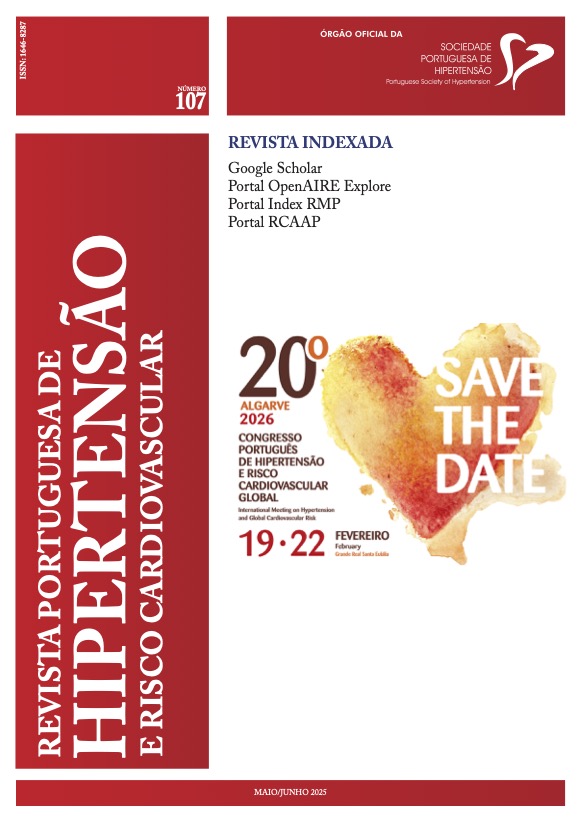CONTROLLING HYPERTENSION – THE ROLE OF THE THERAPEUTIC REGIMEN MANAGEMENT
DOI:
https://doi.org/10.58043/rphrc.141Keywords:
Hypertension, Therapeutic Regimen Management, Control, ElderlyAbstract
Background: Hypertension is one of the most prevalent cardiovascular risk factors in our country and a major cause of disability and morbidity. Its prevalence in the elderly is very high, and this population is also more vulnerable to the risk of polypharmacy and drug interactions. Therapeutic regimen management (TRM) is a tool available in SClínico® and it should be used in nursing consultations.
Objectives: Determine the impact of intervention at the TRM level on controlling hypertension in the elderly population enrolled at USF Murça.
Methods: Users registered at the USF aged 65 years or over, diagnosed with hypertension, were extracted from MIM@UF on 06/2022 and 06/2023. The respective data on blood pressure (BP), body mass index and waist circumference were extracted from SClínico®. The database was collected anonymously in Microsoft Excel® version 16.79.2. Statistical analysis was performed using the IBM® SPSS® program.
Results: Uncontrolled patients in 2022 corresponded to 44% of the total, having decreased to 21% after the interventions. In June 2023, the percentage of users controlled reached 79%. There was an improvement in BP values in 39% of users only with intervention at the TRM, which were now controlled, a statistically significant difference. Of the uncontrolled users, 93% were overweight or obese.
Discussion: The enormous impact that the adoption of the structured assessment of TRM had in consultations with hypertensive patients was demonstrated, in which close to half of hypertensive patients were now controlled only with this intervention, implying that a large proportion of users are not under control due to lack of adhesion to therapy.
Conclusion: Work of this kind shows the importance of non-pharmacological measures in controlling hypertension and contributes to reducing unnecessary prescriptions in particularly vulnerable populations such as the elderly.
Downloads
References
- GBD 2015 Risk Factors Collaborators. Global, regional, and national comparative risk assessment of 79 behavioural, environmental, and occupational, and metabolic risks or clusters of risks, 1990-2015: a systematic analysis for the Global Burden of Disease Study 2015. Lancet. 2016 Oct 8;388(10053):1659-1724.
- Polonia J, Martins L, Pinto F, Nazare J. Prevalence, awareness, treatment and control of hypertension and salt intake in Portugal: changes over a decade. The PHYSA study. J Hypertens. 2014 Jun;32(6):1211-21.
- Prevalência de hipertensão arterial em Portugal – resultados do Primeiro Inquérito Nacional com Exame Físico (INSEF 2015) - INSA. (2017). INSA - Instituto Nacional de Saúde Doutor Ricardo Jorge.
- Eiras A, Teixeira MA, González-Montalvo JI, Castell MV, Queipo R, Otero Á. Consumo de medicamentos en mayores de 65 años en Oporto (Portugal) y riesgo de prescripción de medicamentos potencialmente inapropiados [Consumption of drugs in over 65 in Porto (Portugal) and risk of potentially inappropriate medication prescribing]. Aten Primaria. 2016 Feb;48(2):110-20.
- Norma DGS: Hipertensão Arterial: definição e classificação. Número 020/2011. Atualizada a 19/03/2013.
- Norma DGS: Abordagem Terapêutica da Hipertensão Arterial. Número 026/2011. Atualizada a 19/03/2013.
Downloads
Published
How to Cite
Issue
Section
License
Copyright (c) 2025 Ana Maria Batista Barbosa, Ana Daniela Teixeira Alves, Luís Miguel Claudino Gradíssimo, Vítor Pinto Santos

This work is licensed under a Creative Commons Attribution 4.0 International License.




